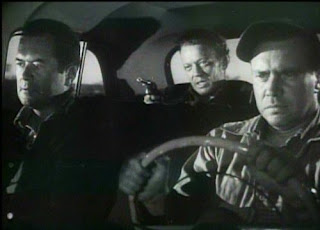The Hitch-Hiker (1953): A Captivating Journey into the Heart of American Film Noir, Directed by Ida Lupino
The Hitch-Hiker, released in 1953, stands as a remarkable example of American film noir, known for its atmospheric tension, moral ambiguity, and dark themes. Directed by Ida Lupino, a pioneering figure in the male-dominated film industry, this gripping crime thriller captivates audiences with its unique premise and suspenseful storytelling. Lupino's directorial prowess shines through as she delves deep into the psyche of her characters, delivering a tense and claustrophobic experience that lingers long after the credits roll.
Watch The Hitch Hiker (1953) American Film Noir Movie Directed By Ida Lupino
Plot and Characters in The Hitch-Hiker (1953)
The Hitch-Hiker follows the sinister tale of two friends, Roy Collins (Edmond O'Brien) and Gilbert Bowen (Frank Lovejoy), who embark on a fishing trip and find themselves at the mercy of a sadistic and cold-blooded hitchhiker, Emmett Myers (William Talman). Lupino wastes no time in establishing the tense atmosphere, portraying Myers as a ruthless criminal who takes control of the situation and forces his captives to comply with his demands. The film's confined setting, a car speeding through desolate landscapes, intensifies the psychological pressure and adds to the sense of impending doom.
Themes and Visual Style
As a film noir, The Hitch-Hiker delves into the darker aspects of human nature, exploring themes such as power dynamics, masculinity, and the consequences of moral compromise. Lupino expertly weaves these thematic threads into the narrative, revealing the complex nature of her characters. The shadowy cinematography, courtesy of RKO veteran Nicholas Musuraca, heightens the film's suspense and contributes to its distinctive noir visual style. The use of low-key lighting and carefully composed shots creates a visually striking experience, emphasizing the moral and emotional ambiguity that permeates the story.
Ida Lupino's Directorial Vision
da Lupino, one of the few women directing during the era, showcased her exceptional talent and distinct directorial vision with The Hitch-Hiker. She infused the film with a keen understanding of human psychology, masterfully portraying the shifting dynamics between the three main characters. Lupino's emphasis on character development adds depth to the narrative, allowing audiences to connect with the struggles and fears of both the captives and their tormentor. Her direction also serves as a reflection of the societal anxieties prevalent during the 1950s, touching upon the fear of the unknown and the crumbling of traditional masculine ideals.
Legacy and Significance of The Hitch-Hike
The Hitch-Hiker, with its unrelenting tension and captivating performances, has earned its place among the classics of American film noir. Ida Lupino's directorial achievements in this genre continue to inspire filmmakers to this day, highlighting her influence as a trailblazing woman in the male-dominated film industry. The film's enduring legacy lies in its ability to unsettle and engage audiences, showcasing the power of atmospheric storytelling and psychological depth.
Conclusion
The Hitch-Hiker, directed by Ida Lupino, stands as a notable example of American film noir, expertly blending suspense, psychological depth, and visual style. Lupino's adept direction and her exploration of complex themes elevate the film, making it a memorable and compelling experience for viewers. The legacy of The Hitch-Hiker continues to resonate, reminding us of the power of female voices in cinema and the enduring appeal of the film noir genre.

Comments
Post a Comment